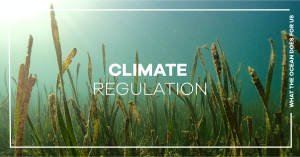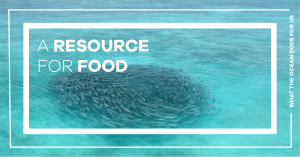In the lead up to World Ocean Day this week, we wanted to recognise all the amazing things the ocean does for us and why it’s so important. The ocean supports the greatest exhibition of life on earth. Countless species depend on the oceans – and humans are no exception. From provision of food, jobs and livelihoods to climate regulation and improving our own happiness, the world’s ocean really is our life support system.

Our climate hero
The ocean is a climate solution. As the climate crisis escalates towards a tipping point, we need the ocean more than ever before. Each year, the ocean absorbs and locks away at least a quarter of all our carbon dioxide from the atmosphere. It also captures around 90 per cent of heat that has been trapped by greenhouse gas emissions.
The ocean contains “blue carbon habitats” that remove carbon from the atmosphere, like seagrass, mangroves and tidal saltmarsh. These habitats play a huge role in mitigating climate change. In fact, some seagrass can absorb carbon 35 times faster than rainforest! It’s not just habitats that play a role in the fight against climate change. Marine creatures like fish and whales, all help too! Unlike terrestrial animals which release carbon into the atmosphere when they die, some carcasses of large marine animals sink and are absorbed in the deep ocean. A single great whale can store 33 tons of carbon dioxide, which is equivalent to the consumption of over 76 barrels of oil.
Not only does the ocean protect us from excess carbon, it also provides the very air we breathe! In fact, the ocean produces as much as 80 per cent of Earth’s oxygen. Much of this is achieved by a microscopic plant-like organisms called phytoplankton that drift around in our ocean. These tiny, photosynthetic powerhouses produce more oxygen than all our tropical rainforests.
The ocean is also responsible for making the planet habitable for humans. It regulates global temperature and drives weather patterns by storing energy from the sun and redistributing heat and moisture around the globe. Ocean currents act like conveyer belts, allowing warm and cold waters to be exchanged between the equator and the poles.
The ocean absorbs most of the excess heat from greenhouse gas emissions, which drive rising ocean temperatures. Climate experts found the ocean has absorbed more than 93 per cent of the excess heat from greenhouse gases since the 1970s. The oceans’ ability to do this has shielded humans from even more rapid changes in climate. Without this buffer, global temperatures would have risen more than they have done to date. A study by the Grantham Institute found that if the same amount of heat absorbed by the ocean between 1955-2010 had been released into the atmosphere, the planet would be 36 degrees hotter than it is today.

Food for thought
The ocean is a major source of food. Over three billion of the world’s population rely on food from the sea as their primary source of protein. Food from the sea is particularly essential to the livelihoods and cultures of many coastal communities and ocean states which lack arable land to farm crops or livestock.
With biodiversity and natural habitats under significant strain, the world is looking to develop new and innovative ways to produce sustainable seafood. A landmark paper, published in Nature, suggests that almost half of all seafood could be sourced from aquaculture by 2050. To protect biodiversity both on land and in the oceans, while providing suitable nutrition to a growing population, development of truly sustainable aquaculture and effective fisheries management are essential.
Important industries
Ocean based industries, such as fishing and tourism, employ millions of people worldwide and provide them with an income. Recent data estimates that a staggering 60 million people are employed in fisheries and aquaculture.
Coastal tourism is dependent on a healthy ocean to keep providing income and jobs to the millions of people who depend on it. 80 per cent of global tourism before the Covid-19 pandemic occurred in coastal areas and prior to 2020, coastal and marine tourism was growing at 3.5 per cent per year and was projected to become the largest segment (26 per cent) of the global blue economy by 2030. In turn, we depend on a healthy ocean for an enjoyable tourist experience. The ocean provides us with an environment for leisure activities like snorkelling, diving, swimming, and water sports as well as providing us with seafood that we like to enjoy while by the coast.

A source of energy
The magnificent force of the oceans – both above and below the water line – could provide the largest source of renewable energy on earth. By harnessing power from the wind, waves and tides, we could supply the energy needs of today’s tech-centred world – leaving fossil fuels in the past. The advancement of ocean energy technologies will allow us to reimagine the way we produce energy and will play a major role in curbing excess carbon dioxide emissions. Some forms of ocean energy, like offshore wind, already produce vast amounts of electricity around the world. The UK is a leader within the sector, with some of the world’s largest wind farms located across the North Sea, providing power to over 4.5 million homes. Other technologies, like the use of ocean salinity and temperature gradients, are yet to be unlocked.

A healthy ocean makes us happy!
The benefits of green space have long been recognised in improving mood, physical and mental health. But what about blue space? Medical studies have identified that humans who spend time in, around and under the ocean experience reduced cortisol – the stress hormone – and increases in feel-good hormones like serotonin, oxytocin and dopamine.
A leading researcher from the University of Exeter, Mathew White, also investigated the link between blue space and mental health. Regular access to the coast has been found to positively impact general happiness, contentedness, stress reduction and cognitive restoration. Though this result is partially through the encouragement of physical activity (walking, swimming, cycling etc.), the greatest influence stems from a sense of connectedness with nature, and with other people.
Blue spaces nurture quality time with friends and family and bring people together in a relaxing environment. Plus, the chance to glimpse a pod of dolphins or spot a diving seabird is bound to brighten anyone’s day!


















